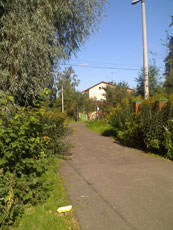|
|
Review of GSM-handset Motorola KRZR K1
Live photos of Motorola KRZR K1
Sales package:
- Handset
- Battery
- Charger
- Wired stereo headset with pick up key
- USB-data cable
- CD with Mobile Phone Tools software
- Memory card (availability and capacity vary by regions, in Russia memory card is missing in the package)
- User’s guide
Motorola has been well known as a manufacturer aimed at developing fetching casings’ curves and creating new design concepts for its products. Its engineers are always in search of new materials, which then get gradually applied in new solutions. Just remember that it was Motorola who made the masses love metal casings, developed such form-factors as clamshell, rotator and offered the idea of «slim» devices. Paying too much attention to the exterior of the device and its image, the company doesn’t always come up with appropriate filling of own-branded products. On release most devices are usually not remarkable for specifications, because their main trump is looks after all, and in this field Motorola is nearly beyond competition. Having launched RAZR range the company has ran into the fact that though the product has appealed to the masses, not all customers have been satisfied with the design. As for me, everyone, or nearly everyone who wanted to, has already bought the product but its sales are not getting down today. It’s hard to follow in the footsteps of RAZR’s success, but over at Motorola they are not giving up on such attempts. Manufacturing of new products under the shade of such commercially successful model raises the bar - for example Motorola PEBL U6, whose design and materials used were quite appealing, hasn’t become a true bestseller, but those who have bought the device like it mostly for the looks. The similar thing happened to Motorola v80 people had kept on literally falling in love with it, but eventually it didn’t become a mass solution.


Other fate is for Motorola KRZR, as it is a highly fashion-charged device claiming to achieve prime sales. On the face of it the model appears exceedingly narrow, but it’s a wrong impression after all. The handset measures 103õ42õ16 mm in size and weights 102 grams. The Model’s dimensions formally keep to those of modern clamshells, sliders and candy-bars. The KRZR’s height and width are nearly alike with Sony Ericsson K800i, Samsung E900 (lower in height). But at that KRZR leaves an impression of a taller and slimmer device. The matter is that the front panel is mirror-like, which allows it to reflect the light and thus makes the device look as it has been stretched out lengthwise. The sides are painted in the same color but covered with matt finishing which adds to the feeling of lightness when holding the handset.
Video, outlook and comparison of dimensions (wmv, 16.3 Mb)>>>





In the sense of size and tactile feelings the model appears to be similar to Nokia 8800, at least it gives you a general feeling of that. Here we mean of course not the materials used, but the impression created by the model’s dimensions, weight and aesthetics. In one case there are glares on the metal and in the other one – glares on the glassy surface.
Some users claim that the KRZR looks fetching owing to minor width, as compared to the RAZR, it is easier to get a grip on (again personal feelings of those who have never played around with the RAZR).
   
The mirror on the front panel brings about the effect of shimmering casing - the light literally comes to life on it. Under different light conditions the handset looks differently, sometimes turning it round and round might make minutes fly by - twinkling of the light grabs your attention and does not let it go. However its major drawback is that the KRZR’s surface is a true fingerprint magnet – be sure to find greasy stains on it promptly. It is one of the easiest devices to soil, that’s why a duster is a must. In addition to that you need to wipe the camera lens, mounted right there as well, otherwise you won’t be satisfied with the snaps’ quality.
As regards mechanical issues, glass doesn’t causes any problems, though no devices boasting such large glass-covered areas have been available up until now, but the manufacturing and mounting technology has already been approved on Motorola PEBL. The glass hardness is rather high, but of course it can be broken, should the things go terribly wrong. The glass is thick enough and keeping in mind the experience of handling the PEBL, I can say the device is unlikely to be broken on falling down.
On release, the KRZR comes in two color schemes – Cosmic Blue and Silver Sail. It isn’t hard to guess that more trims are bound to come a bit later - a red-colored model will appear in February already. In course of this year the pink women-aimed KRZR is most likely to appear on the shelves, as well as other trims, though. Taking into the account that all Motorola’s models have undergone similar color remastering, we can rightfully expect the same steps here as well. The black-colored device is available in Asia and as an exclusive edition of the European model for “Voyager of Discovery” Motorola’s tour participants, and for some VIP persons. Probably, this color scheme might make it to the retail stores this spring.
The external display is embedded in the surface; it is well-visible, just as the inverted picture of the digital watch, on top of that it doesn’t spoil the appearance of the handset at all. Capable of 65K colors, the STN-display with 96x60 pixels (19x16mm) resolution is typical for clamshells manufactured by Motorola. Due to the glass being tinted, the picture outputted by the external display fades in the sun more than it should, so you will end up seeking forr the right angle to read the information.
 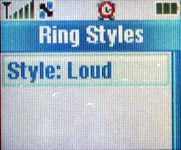
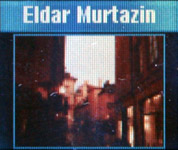 
While in standby mode the external display gets filled up with the status bar, current time and incoming message icon, if there are any. In case a contact you are receiving a call from, is assigned to an image, it will occupy the entire screen, however its quality leaves much to be desired in view of poor display’s resolution.
In the KRZR’s CDMA edition for the Asian market, as well as the one for the US, the handset’s surface houses touch-sensitive dedicated player buttons. Nevertheless there are certain differences between the KRZR K1m for Asia and for the US: in Asia users will get CDMA 800 MHz band, whereas the US edition supports 1900 MHz. For the Asian market the interior display resolution makes 240õ320 pixels at a diagonal of 2 inches. At the same time the camera was «boosted» to 1.3 Mpix for the US market. A-GPS is supported in both cases. But all in all, these two edition are far too different to be faced-off, what they do have in common is curves and shapes of the casing. Apart from the hardware alterations, these two handsets run on different JUIX versions, which becomes evident not only from the preinstalled applications, but from interface layout as well. The Asian model shows off improvements in interface layout that emerges even in camera application and horizontally-arranged icons bar, while the European edition sticks to a more typical layout.
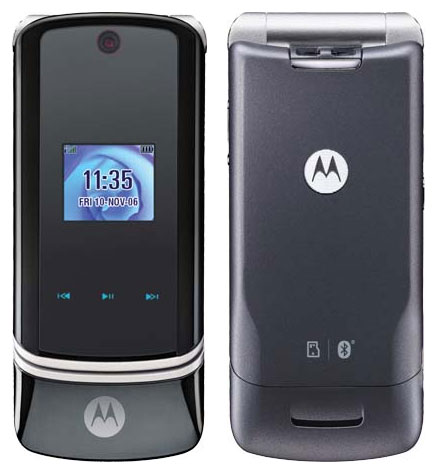
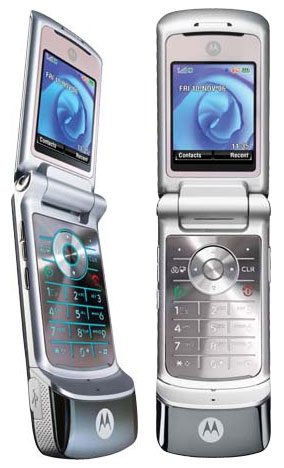
All the design elements have been carefully elaborated. Loudspeaker’s grill is mounted on the front panel. On recharging, a corresponding icon pops up instantly; Bluetooth status is reported with a blue indicator.

The hinge’s sides are filled with framings blending with the casing’s trim. The bottom of the device is made of plastic since the antenna is situated there. At the same time the sides are patterned – might seem to be just meaningless trinkets, but these are the touches that transform a faceless device into a solid and fetching proposal.


The battery cover is made of metal and coated with soft touch spraying, which is velvety by touch. The entire rear plate is similar to the back cover, which makes the device feels really good while held in hands, and on top of that doesn’t slip on the inclined surfaces.


The left side retains the volume rocker switch, and a bit lower – Smart-key. The user is at liberty to customize it and assign to Camera app or something else. While navigating through the menus, this key may double as OK-button or act in a different way, depending on given menu item. On the right one will find Voice Command key standing for voice dialing, voice commands in a standby mode and sound recorder activation during a call. MiniUSB slot for plugging in charger or headset is also embedded in the side plate.

Flipping the KRZR open single-handedly is really easy. While open, it measures 17.5 cm in length, which fits any man or woman, even with large heads. The earpiece hides behind the grill; the display is rounded with a glass-like edging matching the casing’s color. The display itself doesn’t impress, though, for it is a typical Motorola’s screen showing off 176õ220 pixels (30õ37 mm, 1.9 inch) resolution and 262K colors. The image quality isn’t that bad, although it is getting outdated rapidly against the background of competing devices manufactured by Samsung and Sony Ericsson. What it lacks is higher resolution – the picture looks acceptable, but that’s about it. The display can hold up to 6 text and 3 service lines. The TFT technology allows you to read information seamlessly even when in the sun and thus brings no problems.

The keypad implemented into the KRZR is similar to that found on the RAZR style-wise, but on closer examination turns out to match RAZR V3x’s one perfectly. The buttons are equipped with rubberized framings, which make them comfortable to manage. The good thing about the buttons is that they have fairly admirable feedback – the keypad is not flat. All keys are evenly lit in dim blue.



Large rubberized pad placed beneath the keyboard is meant for preventing the display from touching the keypad. However nothing like that does happen – if you let the internal screen get soiled, you will surely notice the keypad-print on it. Generally speaking, the same holds true for other models coming from the RAZR range.
The back cover exposes no gap, and hides the BC50 underneath, which is a 700 mAh Li-Ion battery. As the manufacturer claims the KRZR manages to provide talk and stand-by times of up to 6 and 300 hours respectively on a single full charge. In conditions of Moscow networks the device remained good for 2 days on average at 1 hour of calls, up to 20 minutes of the other functions use and 1 hour of music playback. There aren’t any more capacious batteries available for the device. Anyway, it would be hard to squeeze something more out of the KRZR, as two days is a quite OK lifetime. It takes the handset 2 hours to charge from empty to full.

The SIM-card can be installed only when the battery is detached, while microSD card has hot swap feature, but as might have already guessed, back cover must me taken off prior to swapping cards.
Menu
The European edition of the K1 can be rightfully called the very basic one, as on the whole its standard kit includes minimum applications - the successors to the KRZR are more likely to be significantly revamped. It is sufficient to say that the ATI’s graphics accelerator of the first generation is incorporated here (like in all triplets), and the CPU frequency is the lowest one among other products. It’s also important to note that CPU frequency doesn’t always make all the difference – some CPUs work at 224 Mhz but experience slow downs due to crude software. Here it doesn’t bring about any issues, but such CPU imposes limits on extra functions, for example the device lacks the support for 3D Java.
The KRZR runs on JUIX platform, combining the Linux kernel with Java support (Java+Linux=JUIX). When the manufacturer claims that the similar products will get widely spread on the market and won’t cost a fortune, it means models equal or nearly equal to the KRZR in the sense of feature set. These are definitely not smartphones – such devices remind more of ordinary Motorola’s solutions. Another field – handsets with touch-displays onboard, making use of Linux – is being developed simultaneously, as it’s all another OS version.
Technology-wise the model is nearly a replica of Motorola V3x, at lest, the majority of software features are the same in light of the fact these handsets come from one range.
The handset houses 21 Mb of user-manageable memory, this volume can be expanded with a memory card, where you can keep various applications on. An executable Java file is restricted to 1MB in size (the size of a JAR-file), while the HEAP can top out at 2MB. Actually which memory type is used doesn't matter to the phone when working with files (music, calls, photos, applications), but the interface speed proves to be lower for the internal memory (though it should be vice versa if you come to think of this). This pust a restriction on the bitrate of mp3 files as well. And now the recommended bitrate for the phone's memory is 64 kbps and 128 kbps for the card. However you should treat this statement as recommended by the manufacturer, rather than as a limitation to obey. The phone will play back files with 256 kbps or an alternating bitrate perfectly; problems pop up on rare occasion only for some specific tracks.
Memory for applications is distributed dynamically, 1000 contacts is an assured number of entries that can be saved in the phonebook. An organizer can store up to 500 events and up to 400 tasks (or any combination of them - not more than 900 entries in sum). An MMS is limited by 300 KB in size.
You can access the Main Menu by pressing the Menu key (or OK button, if you like) that is located under the screen right in the middle. The main menu is traditionally features 9 icons; each of them uses information bar for definitions. You can switch the appearance of the main menu to the list mode and then everything will be arranged in plain lists. A half of the submenus is represented as lists and another half as icons (if you choose a corresponding menu appearance). The user may customize the shortcut number navigation, but you can setup shortcuts for almost every menu item or function (including custom ones). For standby mode, the navigation key may call up various applications that are assigned by the user. Further more, you can play around with the options in order to make all icons disappear from the screen until the navi-pad is pressed. Two soft-keys can be bound to various actions as well, apart from the default ones. With such menu flexibility at your disposal the lack of the shortcut number navigation is not that crucial.
Video, handset’s menu (wmv, 7.6 Mb)>>>
 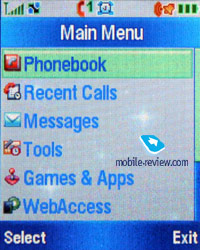
The device supports iTap-powered predictive text input. While typing, the screen displays current words, but hides symbols assigned to the keys. The device remembers the variants of the words you picked and after that offers them automatically. That helps to avoid entering words into the dictionary as it is necessary in T9.
Those using two languages for typing SMS messages will be happy to find out that this option is very manageable on the KRZR. You can also setup which type of text input to use for every language - predictive or not. An interesting solution that extends possibilities for customization of your mobile phone even further. However, I would like to notice that the text input is related to the users and only a small amount of them use more than two languages.
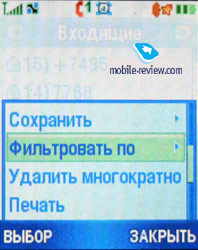 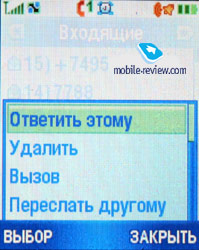
Phonebook. Not less than 1000 names can be saved in the phone's memory and for each entry you can store First Name and Last Name (two fields), Nickname, phone number (select its type in a list - home, work, mobile, fax and so on, available for videocalls or not). At entering a number you will get only one field, but be sure another one will get highlighted after you fill the given field. That means the phone offers step by step data entry, which seems quite logical. And the last but not the least, up to 7 numbers can be kept for a single contact, which is enough for the majority of users.
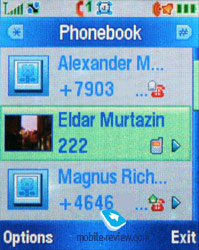 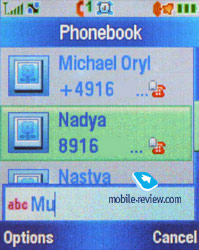
 
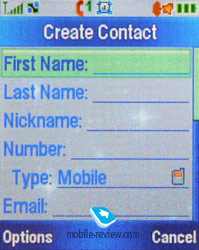 
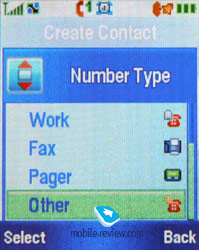 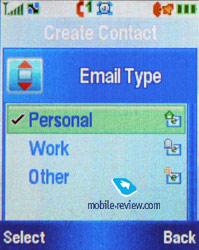
 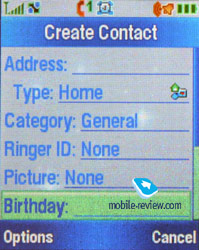
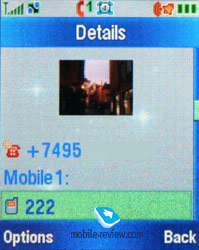 
Apart from telephone numbers you can enter e-mail addresses (up to 2), URL, a postal address (two fields for street, city, state, area code, country). Also we should mention a text note, a personal ring tone, user groups (unlimited number, and each one can have a personal tune), and a birthday. Unfortunately, no reminder on birthday gets scribed in the organizer automatically, no sound signals appear either. I consider it to be the next step in development of the phonebook.
The handset makes use of a speaker-independent voice recognition system, which means no voice tags are required (though they vary by region and selected menu language) – you can dial any contact or call up applications with voice right away.
The general list shows names both from the phone memory and SIM (only one type is viewable at once). Search may be carried out by several letters and you can add until a word is complete. Three view modes of the list are available - only names with an icon of a default number; names and photos and the first phone number (a default one); names with a number. Fast scrolling with the help of horizontal presses is enabled on the KRZR. Any number can be added to the fast dial list, so that you can send a message or call a selected number via a pop-up menu.
The groups settings enable you to pick personal ring tones and images for them – the KRZR houses 4 groups by default, though this number can be easily extended by user. Support for mass message sending to group members is onboard.
A really appealing addition to the interface is filter by e-mail address (sorting of the general list) or recently used numbers (works for SMS as well) – in the latter case the list is topped by Recent Contacts.
You can retrieve contacts from other phones, which is an attractive capability. And if names coincide, two entries are created. If one of the entries has a Nickname field filled up, then the contact will be displayed under this nickname, rather than under the First Name and Last Name. In fact this is one of the first devices that can receive complete information on contact from another device (for example contacts beamed from Sony Ericsson K800i had assigned photos on the KRZR).
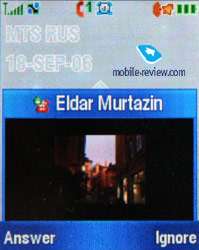
Even despite some possible distortions of encodings for Russian language, synchronization with MS Outlook brings about no problems. We failed in finding the reason why they were so crude, though. However after a complete clean up of all entries and a repeated synchronization, all entries were displayed in normal Russian.
Messages. The default memory capacity for 100 SMS is provided, which may also vary depending on the firmware version. As a rule, operators’ editions are capped to 70 messages. The device can handle EMS if such necessity arises. Automatic cleaning of the whole message list should be mentioned as an extra possibility, as well as a list of templates. Delivery report may be turned on permanently or switched on/off for a given message.
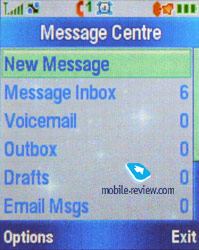 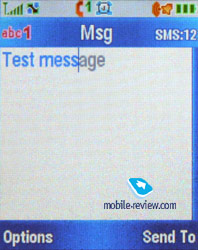
 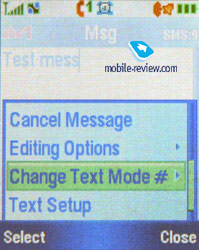
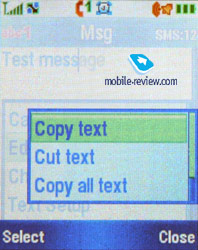 
 
MMS management doesn't cause any inconvenience; everything is simple and easily understandable. The messages can be enhanced with pictures taken with the built-in camera and sound clips. The ten predefined templates are really great, be sure to check them out.
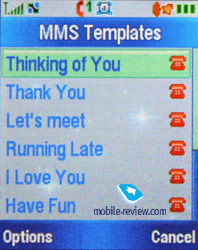 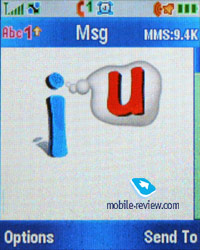
 
The phone has POP3/IMAP4 e-mail client, allowing watching the headers of the incoming mail and downloading their bodies as well. Only images, video, mp3 that do not exceed a certain size limit can be sent. In case you want to store some of the e-mails, you will have to use the dynamically spread memory, just like in case with MMS.
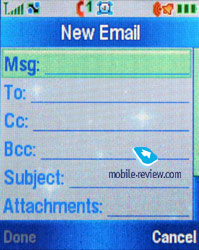
WAP. The phone has WAP-browser v2.0 and its capabilities are standard so nothing special can be said. EDGE (class 12) is enabled, the settings are rather simple, just follow your operator's instructions.
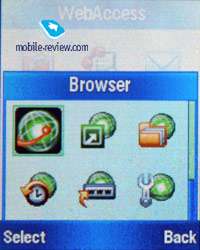 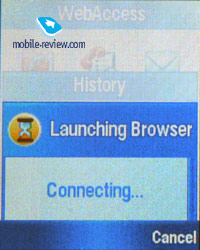

Recent calls. The handset retains a merged list of calls, which means there you will find both missed and dialed numbers. Special lists for 40 recent calls are also available. Not only the caller's name but the type of the number is shown, if it is kept in the phonebook. Everything is rather simple and traditional, nothing special at all. Each entry features the date and time as well as the duration.
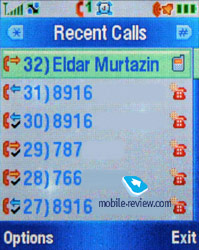 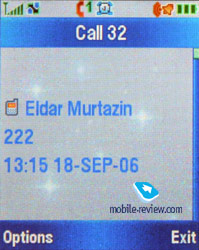
Also this menu shows last calls, call duration and data connections.
Tools. This menu features a whole bunch of office applications such as the Calculator. It's convenient; the full digital keyboard is present on the screen, which reproduces the real keyboard perfectly. The menu features memory options and the unit converter.
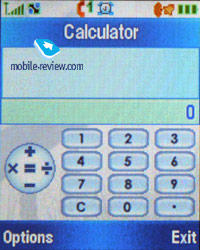 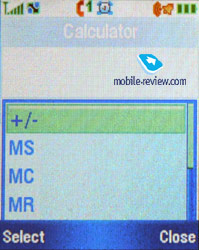
Alarm clock. You can set up several alarm clocks, choose custom ring tones, name and volume, type of reoccurrence (daily, single time) for each of them. This phone was designed for continuous use, that's why entering names and titles for the alarm clocks is required. Alarm clocks are activated in one touch, and a note really makes handling alarms a breeze.
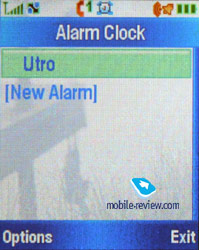 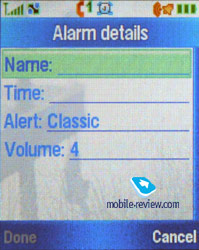
Voice recorder. The recording function can be called up both in standby mode and while calling – in the latter case it records both sides. Maximum duration of a recording is limited only to amount of free space you have on your KRZR. Your interlocutor gets notified if the voice recorder has been started – at first it’s a buzzing sound and then short peeps at regular intervals.
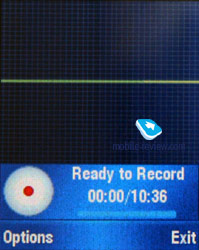 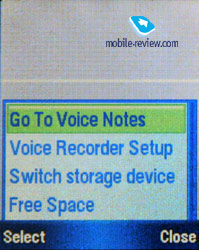
Organizer. You can view it monthly or weekly with breakdown for hours. You will see your appointments bound to a certain time of the day, it's convenient. Each entry can be assigned with a name, start time, length (measured in hours, the minimal amount of time - 30 minutes). Alert can be set up to trigger off before the event (user-manageable). Each entry can set to be recurrent, which is a major attraction.
 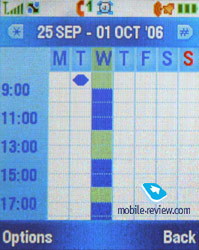
 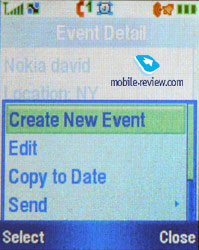

The To Do list is missing in the KRZR.
SyncML support is enabled on the KRZR, which is aimed at enterprise users who are in great need of synchronization with data server (a kind of remote synchronization with Desktop PC, but this time the server must be located in the network).
Activation List – the handset boasts support for DRM 2.0, so that in the Activation list you can check out licenses, their status etc.
Games and applications. The phone supports Java MIDP 2.0; all applications that are located in this menu item are based on this technology. The number of games and their title depends on where the phone was bought. In most cases you will end up having only Sudoku game onboard.
 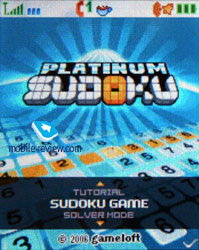
 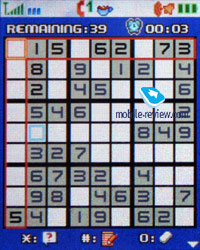
From this point on, the Applications menu holds K1 Help items, which is a kind of guide to the device’s main feature. Even though a MP3-player is available, it’s not of much use, since it cannot be minimized, as well as Java-based applications on the whole (Suspend is the only supported feature).
 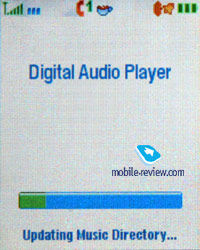
 
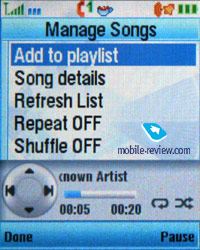 
Multimedia. The phone supports themes. It's a set of wallpapers, color schemes for the menu, sounds and ring tone types. You can change the outlook of your phone almost instantly and this is really amusing. New themes can be downloaded from Motorola's website.
The number of available skins has been modified and now they look differently as well. They not only change menu color, but the windows as well as the rest of the interface, which is quite nice thing to play around with.

Sounds - information about all sound files stored in the phone's memory is located here. You can check out their size, info and even listen to them. The player found on the KRZR is similar to other Motorola's phones, everything is clear and easy to understand. The great advantage of this very player is playing back mp3's in background mode. You can draw you own play lists with the help of corresponding tools. Having closed the device you will surely notice that track list is displayed on the external screen, and on top of that is very manageable with the help of side-buttons and the Smart-key, which is quite convenient. Support for MP3, as well as AAC and AAC+ is onboard.
Pictures - list of all images located in the phone's memory. There's a special icon placed next to each file. Every picture can be set as the wallpaper or screensaver. Pictures can be sorted by categories; which makes browsing easier.
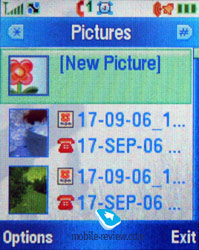
Moreover, you can use a built-in editor, which allows overlaying frames, changing color scheme and using special effects. The most convenient part is that after editing a picture it can be stored with a new name. This means that both the original and the new picture will be available for use. This may come in handy in case you want to edit the photo, and not to ruin the original.
Settings. Here you can setup all Display settings including the color schemes.
Ring tone type and notification mode (mixed mode, when the silent alert goes off at the same time with the ring tone) is here as well.
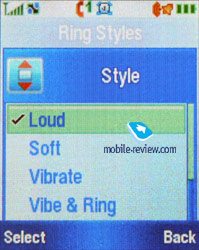 
Here you can activate the Flight mode and set an alert on its activation. The fact that profiles are missing on the KRZR frustrates a little, however the Flight mode is the first step towards fully-functional profiles.
Security settings have been expanded greatly. Now you can protect some functions with a password, which may be the phonebook, messages, or some other phone sections.
Bluetooth settings were slightly modified; Now, the Print option is available, printing is possible for a message, an organizer note or a phonebook entry.
 
The supported standard is 1.2; apart from the Print profile the handset now can provide Audio Profile (A2DP), which allows pairing up a stereo headset with it. You can't use fast forward feature from the headset; however it will certainly help you to switch tracks. Bluetooth data transfer speed tops out at nearly 25-30 Kb/s.
Camera. With an integrated 2 Mpix CMOS module you can take photos of four resolutions - Large (2MP), Medium (1.2 MP), Small (480x640), X-Small (240x320). Three grades of compression are available. Other settings allow turning off the shutter sound, exposition from -2 to +2, selecting a lighting type (auto, sunny, cloudy, indoors, office). Self-timer feature is also enabled.
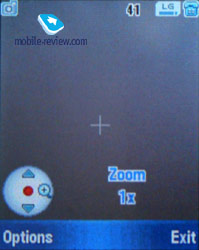 

Best results are achieved in bright sun light, whereas in other cases color saturation is far from sufficient. A fetching peculiarity is that a photo is shown in full-screen mode when managing with the camera, while the tips are semitransparent. You can change lighting settings with vertical declinations of the navigation button, as well as select various effects (color, black and white, blue, old-like, red, green, and negative). Digital zoon (up to x8) is at your disposal.
Quality of taken photos is far inferior to that made by Motorola V3x, it would be even better to call it poor. The explanation lies in the fact that the KZRZ doesn’t make use of NVidia GoForce 4800 accelerator for shots processing, found n the V3x. Being the worst in its class in the sense of photos quality, the KRZR provides only a tiny share of snaps that can be demonstrated on PC.
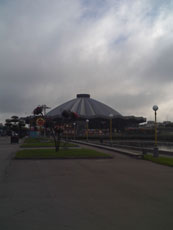 |
 |
(+)
maximize, 1600x1200, JPEG |
(+)
maximize, 1600x1200, JPEG |
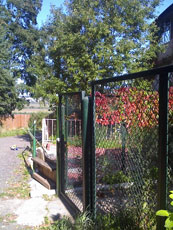 |
 |
(+)
maximize, 1600x1200, JPEG |
(+)
maximize, 1600x1200, JPEG |
 |
 |
(+)
maximize, 1600x1200, JPEG |
(+)
maximize, 1600x1200, JPEG |
 |
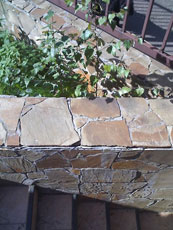 |
(+)
maximize, 1600x1200, JPEG |
(+)
maximize, 1600x1200, JPEG |
 |
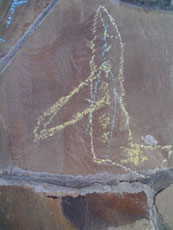 |
(+)
maximize, 1600x1200, JPEG |
(+)
maximize, 1600x1200, JPEG |
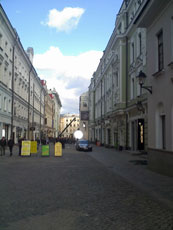 |
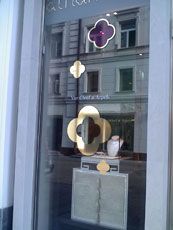 |
(+)
maximize, 1600x1200, JPEG |
(+)
maximize, 1600x1200, JPEG |
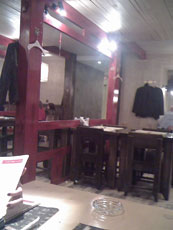 |
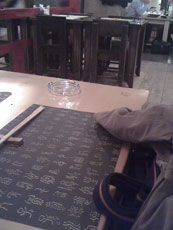 |
(+)
maximize, 1600x1200, JPEG |
(+)
maximize, 1600x1200, JPEG |
 |
 |
(+)
maximize, 1600x1200, JPEG |
(+)
maximize, 1600x1200, JPEG |
 |
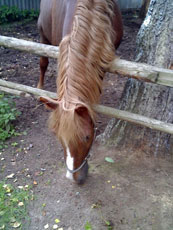 |
(+)
maximize, 1600x1200, JPEG |
(+)
maximize, 1600x1200, JPEG |
 |
 |
(+)
maximize, 1600x1200, JPEG |
(+)
maximize, 1600x1200, JPEG |
 |
 |
(+)
maximize, 1600x1200, JPEG |
(+)
maximize, 1600x1200, JPEG |
Here you can check out sample of photos with overlaid special effects.
 |
 |
(+)
maximize, 1600x1200, JPEG |
(+)
maximize, 1600x1200, JPEG |
 |
 |
(+)
maximize, 1600x1200, JPEG |
(+)
maximize, 1600x1200, JPEG |
 |
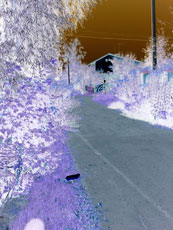 |
(+)
maximize, 1600x1200, JPEG |
(+)
maximize, 1600x1200, JPEG |
You can select the quality for video - good, better, the best. The maximum clip duration reaches 10 minutes. And it is curious that the interface for still images differs from the video capturing mode and calls up another menu item. You can change the settings quickly, however the picture takes only a part of the screen, which is caused by the clip resolution (low - 128x96 pixels, high - 176x144 pixels). Video quality is average; sound recording can be disabled for any given video clip. All clips are recorded at 15 frames per second.
Video sample (3gp, 428 Kb)>>>
Performance. Taking account of how low the CPU frequency is, we could not expect the KRZR to raise the bar, on the contrary our worst fears came true, as it turned out to be one of the market’s worst performers. Missing support for 3D Java didn’t allow us to carry out corresponding test.
| JBenchmark 1 |
|
| Model name |
Moto K1 |
| Firmware version |
|
|
|
| Jbenchmark 1 |
1.1.1 |
|
|
| Version |
|
|
|
| Total Score: |
1652 |
|
|
| Details: |
|
| Text |
418 |
| 2D Shapes |
452 |
| 3D Shapes |
212 |
| Fill Rate |
86 |
| Animation |
484 |
|
|
| Screen Width |
176 |
| Screen Height |
179 |
| Color Screen |
true |
| Number of Colors |
65536 |
| Double Buffer |
true |
| Total Memory |
841688 |
| Free Memory |
531928 |
|
|
| MicroEdition Configuration |
CLDC-1.1 |
| MicroEdition Profiles: |
MIDP-2.0 |
| Microedition Platform: |
j2me |
| Microedition Encoding: |
ISO-8859-1 |
| Microedition Locale |
en |
| Jbenchmark 2 |
|
|
|
| Version |
2.1.1 |
|
|
| Total Score: |
36 |
|
|
| Details: |
|
| Image Manipulation |
39 |
| Text |
98 |
| Sprites |
76 |
| 3D Transform |
5 |
| User Interface |
39 |
|
|
| Screen (canvas) Width |
176 |
| Screen (canvas) Height |
179 |
| Color Screen |
true |
| Number of Colors |
65536 |
| JPEG Support |
true |
| Transparency (Alpha Level) |
4 |
| Double Buffer |
true |
| Total Memory |
841136 |
| Free Memory |
553952 |
|
|
| MicroEdition Configuration |
CLDC-1.1 |
| MicroEdition Profiles: |
MIDP 2.0 |
| Microedition Platform: |
j2me |
| Microedition Encoding: |
ISO-8859-1 |
| Microedition Locale |
en |
Synchronization with PC. A full version of Mobile Phone Tools version 4.x is included into the package. The program capabilities cover the needs of the majority of users: they include synchronization with MS Outlook, making reserve copies on a PC, copying photos, tunes, drawing up messages on the PC. ActiveSync Exchange support is also onboard, though only remote synchronization is provided (with a mainframe via network).
Impressions
The model delivers good receiving quality, typical for all modern devices. Ring tones’ volume is slightly above average, midi-tunes are played back via 64-chord polyphony module, which ensures fairly great sounding. The silent alert is nothing special on the KRZR – it’s somewhere between “average” and “slightly above average” strength-wise. The loudspeaker outputs enough volume during conversations for nearly all environments.
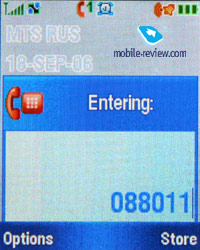 
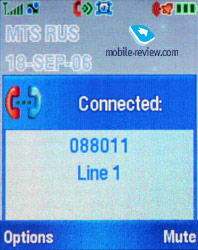 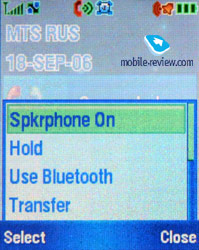
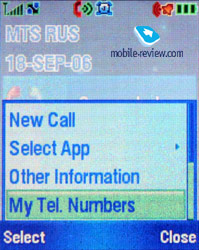 
It is one the first Motorola-branded models with improved speaker; during a call made within coverage area of an operator with AMR-codec, you will notice that voice has gotten much clearer. But sometimes that might cause some kind of confusion - the silence in the earpiece occasionally made me think the man on the other end had hung up.
This device can’t be called a revolutionary - it’s rather a kind of evolution of the design concept and a new approach to the materials the casing is made of. In future we are going to see more models basing off the KRZR hit the market (for example the Asian edition will be enhanced and introduced under a different index). In the sense of building quality the handset is flawless; it is well-assembled, and somewhat similar to an expensive watch model. The eye-grabbing design lives up to the bar of quality - As a matter of fact the design is the key attraction of the KRZR, whereas its feature set could barely impress someone today. The camera module here is rather mediocre and moreover is covered with constantly soiling glass; the player is quite unsophisticated either, though it handles basic music playback without any problmes (no extra features are available like those on lately announced Nokia’s devices or Sony Ericsson’s old Walkmans). The phonebook got amplified again, which has made it more functional; however for unknown reasons To Do list in the organizer has gone missing. For those interested in a feature-packed model, this model will hardly do. The KZRZ is rather a fashion-only solution with calls being its main aim.
Motorola KRZR K1 is hitting the selves by the end of October at a starting price of 550-600 USD in Russia (European retail price makes about 400 Euro). The RAZR and other company’s models started their way in this price-bracket as well, but the reality makes it clear that price for handsets drops down in time, especially when they are not in popular demand (for example the PEBL).
SAR value for the model is 1.39 W/kg.
Eldar Murtazin (eldar@mobile-review.com)
Translated by Ilya Baranov (oleg.kononosov@mobile-review.com)
Published — 20 October 2006
Have something to add?! Write us... eldar@mobile-review.com
|
News:
[ 31-07 16:21 ]Sir Jony Ive: Apple Isn't In It For The Money
[ 31-07 13:34 ]Video: Nokia Designer Interviews
[ 31-07 13:10 ]RIM To Layoff 3,000 More Employees
[ 30-07 20:59 ]Video: iPhone 5 Housing Shown Off
[ 30-07 19:12 ]Android Fortunes Decline In U.S.
[ 25-07 16:18 ]Why Apple Is Suing Samsung?
[ 25-07 15:53 ]A Few Choice Quotes About Apple ... By Samsung
[ 23-07 20:25 ]Russian iOS Hacker Calls It A Day
[ 23-07 17:40 ]Video: It's Still Not Out, But Galaxy Note 10.1 Gets An Ad
[ 19-07 19:10 ]Another Loss For Nokia: $1 Billion Down In Q2
[ 19-07 17:22 ]British Judge Orders Apple To Run Ads Saying Samsung Did Not Copy Them
[ 19-07 16:57 ]iPhone 5 To Feature Nano-SIM Cards
[ 18-07 14:20 ]What The iPad Could Have Looked Like ...
[ 18-07 13:25 ]App Store Hack Is Still Going Strong Despite Apple's Best Efforts
[ 13-07 12:34 ]Infographic: The (Hypothetical) Sale Of RIM
[ 13-07 11:10 ]Video: iPhone Hacker Makes In-App Purchases Free
[ 12-07 19:50 ]iPhone 5 Images Leak Again
[ 12-07 17:51 ]Android Takes 50%+ Of U.S. And Europe
[ 11-07 16:02 ]Apple Involved In 60% Of Patent Suits
[ 11-07 13:14 ]Video: Kindle Fire Gets A Jelly Bean
Subscribe
|



















































































































